10 top autumn garden tips and plants
Here are key autumn garden tips plus 7 top suggestions of plants to plant now.
You may be tempted to stop gardening in autumn, but if you do, you’ll be missing a trick.
Because now is the best time to plant most perennials.
So here is a selection of plants to plant now.
They’ve been recommended by plant growing experts from a collective of independent plant nurseries called the Plant Fairs Roadshow. This group of nurseries set up plant fairs in beautiful gardens around the UK between spring and autumn.

Autumn flowering plants aren’t all in shades of rust and gold – there are lots of pretty pastels, too. Top is Helianthus ‘Carine’ from Pineview Plants. The pic above is Ornamental Oregano from Hardy’s Cottage Garden Plants
Visitors to the gardens get free entry to the road shows as well as the chance to buy plants from people who grew them. This means that they can give you the right advice about how they’ll grow in your gardens. And there’s also a ‘plant doctor’ on hand.
I caught up with the Plant Fairs Roadshow at Mount Ephraim Gardens in Kent. The No Name Nursery, Hardy’s Cottage Garden Plants, Miles Japanese Maples, Pineview Plants, Pelham Plants and Dan Cooper Garden were there, and have shared good autumn garden info with us.
Why plant in autumn (or fall)?
You may be tempted to forget about the garden as the nights draw in. But autumn – or fall, as it’s also known – is a brilliant time to plant perennials, bulbs and trees.
Steve Edney, who owns the No Name Nursery in Kent, with his partner Louise Dowle, explains that the soil is still warm.
‘The plants get a chance to start growing. Then when the weather gets colder, they go dormant, but are in a good position to start growing immediately when spring comes.’
However, when you plant in spring, the ground may still be cold. And when summer comes, sometimes quite quickly afterwards, too much heat could put newly planted plants under strain.
‘There’s no wrong time to plant a perennial,’ says Steve. ‘But there are optimum times. And autumn is the best time. Spring is the second best time.’
Steve also says that if you have heavy clay soil, plant your perennials just slightly above the soil, as if planted on a small mound. Autumn can be rainy and this helps with drainage.
There’s more about planting in autumn here.
Why plant perennials now?
If you have a gap in your garden in spring or summer, then you’ll get the most instant colour by planting annuals. These are plants that grow from seed, flower and die in one year.
But annuals therefore need replacing every year. And by autumn, they are at the end of their lifespan.
But perennials are plants that live in your garden for three years or more. You can plant them now and they’ll fill a gap.
And they’ll come back next year (and the year after) looking even better.
They’re good value for money and less effort than ‘bedding plants’ because you don’t have to keep digging them up and replacing them. There’s more about choosing perennials in perennials made simple.

Two very different styles of perennial autumn border. Top is the border at Antique Perennials in Southern Australia. The pic above is Steve Edney and Louise Dowle’s No Name Nursery long perennial border in South East England.
It’s also the best time of year to plant trees
Miles Hayward runs Miles’ Japanese Maples, where he sells a range of different maples from around the world. ‘Autumn is absolutely the best time to plant, particularly with the way our weather has been recently.’
Very dry spring weather makes it hard for trees to get established, and you’ll need to water them more.
It’s important not to plant your tree too deep. ‘Especially if you’re planting on a heavier soil,’ says Miles, who also advises planting on a slight mound so that where the roots meet the trunk is just above the level of the soil.
He advises planting a young maple ‘just as the leaves are starting to fall.’ (See more about how to plant a tree correctly here.).
I asked Miles how to keep a maple the right size for a smaller urban garden. ‘Japanese maples – acer palmatum – aren’t large trees anyway,’ he says. ‘But the best way to keep the growth under control is to prune in mid-summer, as you do for espaliered fruit trees. You’re controlling the vigour of the tree by removing some of the foliage, and that helps to control the size. They also tend to heal better at that time of year.’
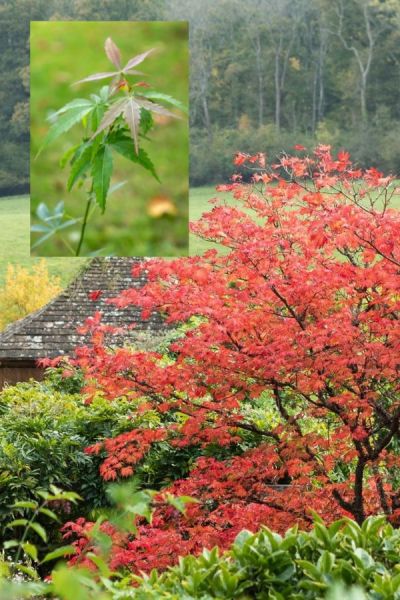
Acer palmatum (inset) is a good tree for a smaller garden, according to Miles of Miles’ Japanese Maples who suggests planting them in autumn and pruning in mid-summer.
Best autumn-flowering perennials to plant now
Asters – forgotten heroes of the late season border
I asked Steve for a perennial which would fill a gap in your border now and look good for years to come. His favourite pick was a pretty and unusual aster – Aster ‘Pink Buttons.’
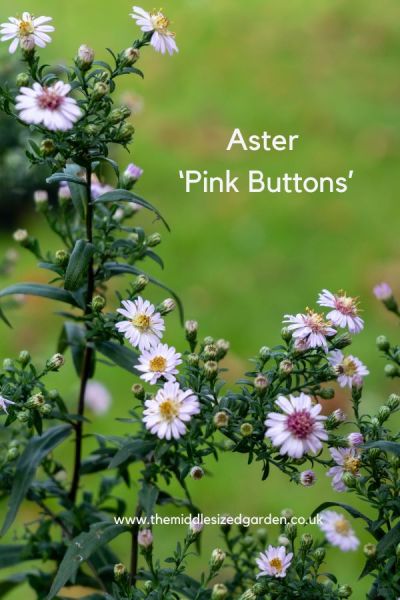
Aster ‘Pink Buttons’ will be completely covered in tiny pink flowers when it’s fully out. It’s available from the No Name Nursery, who are part of the Plant Fairs Roadshow, but Steve also recommends asters generally as easy, colourful, resilient autumn flowering perennials.
Asters are an excellent choice for filling a gap in your garden now, according to Steve.
‘They’re good do-ers,’ he says. ‘They’re hard to kill and stalwarts of the autumn border for most people.’
Asters used to be dismissed as a common plant. Perhaps they’re too easy to grow. They have pretty daisy-like flowers from late summer onwards.
Now the botanists have re-classified many of them, because although many look similar, they are not all genetically related. Some are native to North America. Others are native to the UK, Europe and Asia.
As non-experts, however, we can still call this large family of gorgeous flowerers by their common name ‘asters.’
Just brace yourself for a bit of botanic disapproval. See this post for an explanation of why ‘Latin’ or botanic plant names are changed and why this matters.

Top: asters are the stalwarts of an autumn border, and you can get unusual varieties. I’ve lost the name of these tiny purple asters on top of tall branching stems in my garden but the blue Aster amellus ‘King George’ in the picture is a perennial favourite.
Hylotelephium (formerly sedum) – autumn flowers and winter structure
Rosy Hardy of Hardy’s Cottage Garden Plants recommends Hylotelephium (formerly sedum) ‘Matrona’ for planting now. It will last for years in your garden, flowering in late summer, throughout autumn and giving you structural seedheads in the winter.
Hylotelephium is very hardy – down to minus 40C/minus 40F so it will survive winter in a wide range of gardens.
This is another plant which has recently been re-named when botanists analysed its DNA and discovered that it wasn’t related to the sedums that we also called ‘stonecrops.’
Hylotelephium is a perennial-lovers’ favourite. It’s resilient, easy to look after and perfect for pollinators.
‘It’s a really beautiful shape,’ says Rosy. To stop it flopping, reduce the size by half in summer.
‘Here in the UK, we call it The Hampton Hack, because the Hampton Court Flower Show is in early July,’ she says. ‘Reduce the height to around 4″-5″ and it’ll flower slightly later but won’t need support.

Hylotelephium ‘Matrona’ is loved by pollinators and also recommended in our post on 10 beautiful but tough perennials for wet and dry summers.
Ornamental oregano
Rosy also recommended a beautiful flowering herb – Ornamental oregano or Oreganum laevigatum. It has pretty purple flowers on wiry stems that won’t need supporting. ‘It has lovely perfumed foliage,’ adds Rosy.
This plant is very hardy and will winter down to minus 28C/minus 20F. ‘It’ll fill a gap in a sunny border to part-shade,’ she says.
Ornamental oregano is another easy care plant. Rosy says that you can cut it down when the flowers are over, ‘but you don’t have to.’ It’ll clump out and in the spring, you’ll get a lovely mat of foliage.’
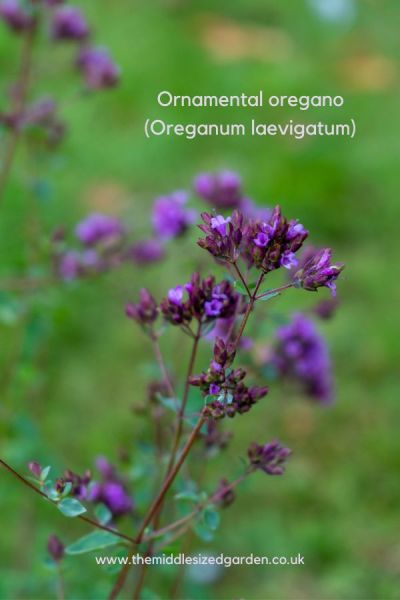
Ornamental oregano – an easy-care autumn flowering perennial to plant now. From Hardy’s Cottage Garden Plants.
White Japanese anemone – less of a spreader than the pink
Colin Moat of Pineview Plants recommended another perennial that is often overlooked. – Japanese anemone ‘Honorine Jobert’.
Japanese anemones stand quite tall in the garden and don’t need staking, says Colin. ‘Which is important for me because I always get around to it too late.’
Many of us have found that the pink Japanese anemones can be quite thuggish in our gardens, but Colin has found the white version relatively well behaved. It also has a profusion of flowers and ‘is a really charming plant.’
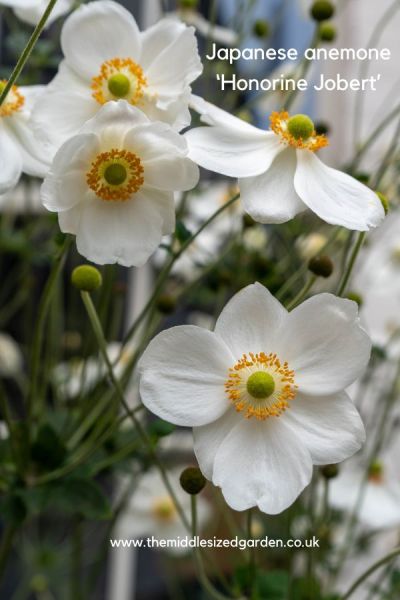
Japanese anemone ‘Honorine Jobert’ is less of a thug than the pink Japanese anemone. From Pineview Plants
Ornamental grasses 1 – Miscanthus
Autumn is the time when ornamental grasses whisper in the wind, adding movement and autumn colour to gardens.
Colin says that miscanthus is one of his favourite autumn ornamental grasses. ‘But some miscanthus have very broad shoulders,’ he says. They can turn into very large clumps in the garden.
So he recommends Miscanthus nepalense, a more compact miscanthus, with wonderful gold tassels.
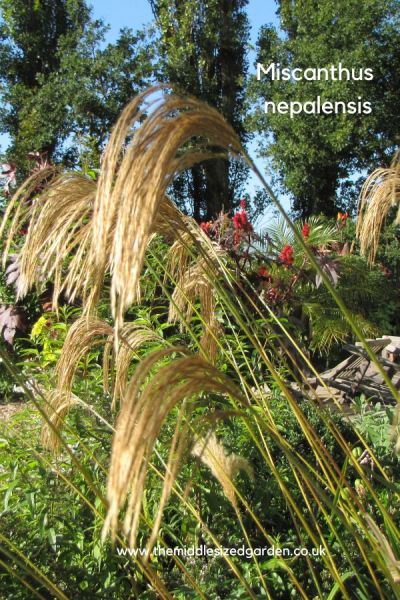
Miscanthus nepalensis from Pineview Plants – an ornamental grass that stays compact in smaller gardens.
Ornamental grasses 2 – Pennisetum
Paul Seaborne of Pelham Plants also recommends grasses for this time of year. ‘At this time of year, they offer such wonderful textures and tones.
Even when your other perennials are finishing, the grasses will come into full flower.’
Pennisetum ‘Black Beauty’ is one of his favourites. ‘It has one of the darkest flowers and it’s a really tough, quick-growing grass.’ It bulks out really well and flowers quite late in the season.
‘But the big jet-black flowers will hold fast in most winters,’ he says. They look wonderful with dew, frost or cobwebs on them, and the autumn leaves often turn interesting colours too.
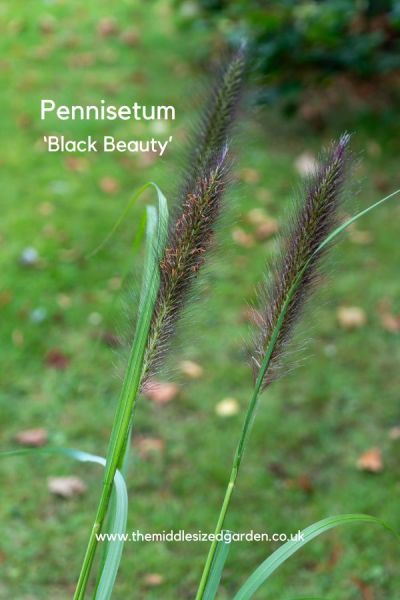
Pennisetum Black Beauty from Pelham Plants holds its dark plumes well over the winter. They look beautiful with frost or raindrops.
Perennial sunflowers – Helianthus ‘Carine’
Paul also recomended Helianthus ‘Carine’ as a ‘particularly good perennial.’ It’s smaller than most perennial sunflowers – around 4ft/12ocm tall.
‘It’s fantastic for pollinators, upright and bulks out nice and quickly. ‘It has a lovely glow at this time of year and it looks good mixed in with grasses, too.’
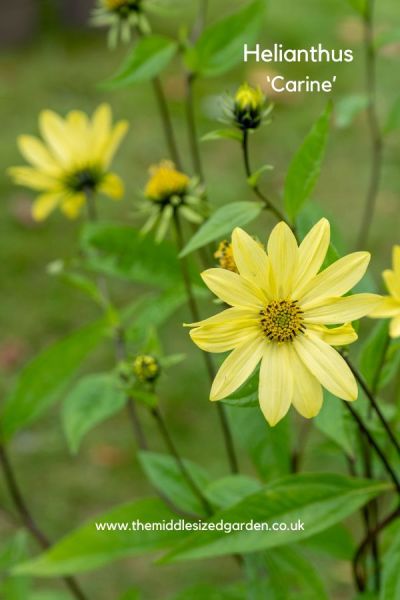
Helianthus ‘Carine’ is a pretty lemon-yellow perennial sunflower from Pelham Plants
Best autumn garden tip: plant bulbs in early autumn but plant tulips later
Dan Cooper of Dan Cooper Garden (garden tools and accessories) is also part of the Plant Fairs Roadshow. He says that autumn is a good time to plant daffodils, crocus, hyacinths and alliums.
‘But don’t plant tulips until early winter ‘- the end of November or beginning of December in the UK. ‘That’s because tulips like the ground to be cold,’ he says. ‘If the ground is still too warm and you have a lot of rain, then tulips are more likely to get tulip fire.’
Tulip fire is a viral disease, which causes greying stripes on leaves along with distorted foliage and flowers. After last year’s wet autumn, several of my longest-established tulips went down with tulip fire.
If you have tulip fire in your garden, it’s hard to get rid of it. You’d be better off planting your tulips in pots. Dan has created an amazing ‘border’ out of pots in his own courtyard garden. See his advice in how to group pots – plus practical container planting tips.
Dan has two specialist bulb planting trowels. One is the Dutch Style Planting Trowel from the tulip fields of The Netherlands. It has a flat heart-shaped blade which you plunge into the soil and pull forward in a single motion (so no digging). You can see Dan demonstrating it in the video here. Go to >The blade is exactly three times the height of a tulip bulb, which makes getting the depth of the hole much easier because that’s how deep you need to plant tulips.
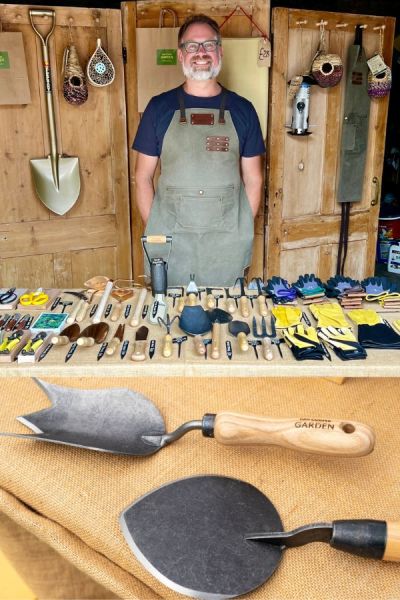
Bulb planting trowels from Dan Cooper Garden – available online or from plant fairs around the UK. The top is called a Tulip Trowel because of its spiky edges, but it can be used for any planting in heavy soil or around tree roots. The heart-shaped flat trowel comes from the tulip fields of the Netherlands.
Find a plant fair near you
Plant fairs are a particularly good place to buy plants.
That’s because small independent nurseries grow their own plants and are often expert in one particular group of plants. You can ask questions about how the plant will grow in your garden and get answers from someone who grows it in theirs.
Plants may be healthier because they haven’t had to ravel so far, and you’re likely to discover plants that do well in your local area.
There are a number of plant fairs around the world, so you can put ‘plant fair near me’ into a search engine to find them.
The Plant Fairs Roadshow operates across South East England from around Easter to the end of September. The 2024 dates are not yet up, but you can sign up here to get an email which will tell you when plant fairs are coming up.
Some of the Plant Fairs Roadshow nurseries will also be at the Great Dixter Plant Fair in early October.
Pin to remember top autumn garden tips
And do join us. See here to receive a free weekly email with more gardening tips, ideas and inspiration.
























